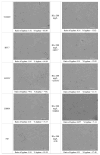Bacteriophages Improve the Effectiveness of Rhamnolipids in Combating the Biofilm of Candida albicans
- PMID: 40333731
- PMCID: PMC12029421
- DOI: 10.3390/molecules30081772
Bacteriophages Improve the Effectiveness of Rhamnolipids in Combating the Biofilm of Candida albicans
Abstract
Biofilms formed by Candida albicans pose therapeutic challenges due to their resistance to conventional antimicrobials, highlighting the need for more effective treatments. Rhamnolipids (RLs) are biosurfactants with diverse antimicrobial properties. Bacteriophages are viruses that target specific bacterial strains. Recent studies have shown that they may affect biofilm formation by fungi and yeasts. This study investigated the combined antimicrobial effects of RLs and bacteriophages against C. albicans biofilms, focusing on their anti-adhesive and inhibitory effects on biofilm development. RT-PCR assays were used to analyze gene modulation in C. albicans biofilm formation in response to RLs and bacteriophage treatments, while hyphae formation was examined using microscopy. The results showed that RLs-bacteriophage combinations significantly reduced biofilm formation compared to individual treatments. A combination of 200 mg/L RLs with bacteriophage BF9 led to a 94.8% reduction in biofilm formation. In a subsequent model, the same RL concentration with bacteriophage LO5/1f nearly eliminated biofilm formation (~96%). Gene expression analysis revealed downregulation of key biofilm-associated genes when Candida cells were treated with 200 mg/L RLs and four bacteriophages (BF17, LO5/1f, JG004, FD). These results show the potential of RL and bacteriophage combinations in combating C. albicans biofilms, presenting a promising therapeutic approach against resilient infections.
Keywords: Candida albicans; antimicrobial agents; bacteriophages; biofilm assay; combined therapy; rhamnolipids.
Conflict of interest statement
The authors declare no conflicts of interest.
Figures





Similar articles
-
Inhibitory Effect of Sophorolipid on Candida albicans Biofilm Formation and Hyphal Growth.Sci Rep. 2016 Mar 31;6:23575. doi: 10.1038/srep23575. Sci Rep. 2016. PMID: 27030404 Free PMC article.
-
Thymus vulgaris essential oil and thymol inhibit biofilms and interact synergistically with antifungal drugs against drug resistant strains of Candida albicans and Candida tropicalis.J Mycol Med. 2020 Apr;30(1):100911. doi: 10.1016/j.mycmed.2019.100911. Epub 2019 Nov 7. J Mycol Med. 2020. PMID: 32008964
-
Synergic Effect of the Antimicrobial Peptide ToAP2 and Fluconazole on Candida albicans Biofilms.Int J Mol Sci. 2024 Jul 16;25(14):7769. doi: 10.3390/ijms25147769. Int J Mol Sci. 2024. PMID: 39063009 Free PMC article.
-
Development and regulation of single- and multi-species Candida albicans biofilms.Nat Rev Microbiol. 2018 Jan;16(1):19-31. doi: 10.1038/nrmicro.2017.107. Epub 2017 Oct 3. Nat Rev Microbiol. 2018. PMID: 29062072 Free PMC article. Review.
-
Pathogenesis of Candida albicans biofilm.Pathog Dis. 2016 Jun;74(4):ftw018. doi: 10.1093/femspd/ftw018. Pathog Dis. 2016. PMID: 26960943 Free PMC article. Review.
References
-
- Sarubbo L.A., Maria da Gloria C.S., Durval I.J.B., Bezerra K.G.O., Ribeiro B.G., Silva I.A., Twigg M.S., Banat I. M Biosurfactants: Production, properties, applications, trends, and general perspectives. Biochem. Eng. J. 2022;181:108377. doi: 10.1016/j.bej.2022.108377. - DOI
MeSH terms
Substances
Grants and funding
LinkOut - more resources
Full Text Sources

